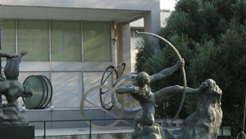

Greece
The Byzantine museum is located northeast of the Acropolis (Its-Kaleh) of the castle of Ioannina. It is a two storey building, on the ground floor of which the main exhibition is housed, comprising of findings (sculptures, coins, ceramics, pictures, bema doors, gospels) from the 4th to the 19th century.
The Byzantine museum is located northeast of the Acropolis (Its-Kaleh) of the castle of Ioannina. It is a two storey building, on the ground floor of which the main exhibition is housed, comprising of findings (sculptures, coins, ceramics, pictures, bema doors, gospels) from the 4th to the 19th century.
The permanent exhibition is laid out in seven rooms, corresponding to three exhibitional units: Paleochristianic, Byzantine, Metabyzantine. The jewellery exhibition is a part of the museum. There are exhibited ecclesiastic and various personal collections’ exhibits.
The museum is equipped with a workshop for the maintenance of ceramics, murals, mosaics and stone, as well as storage space in the underground area of findings’ reception.
The aim of the Ioannina Byzantine Museum is to collect, protect, study and promote works and objects of art from the 4th to the 19th century. Also, to be the center of a space of civilization, housing musical and theatrical events, temporary exhibitions etc.


This beach is located in the town of Chania, and owes its’ name to its’ golden sand! Perfectly organised, with umbrellas and chairs, it is the best choice for familiew not wanting to wander far away from their base.


The National Gallery has in its collections more than 17.000 works of painting, sculpture, engravings and other forms of art, and is the treasury of the recent Greek artistic creativity, covering a timespan from the metabyzantine days up to our days.


It is a paved road that leads from the Lions Square to the 18 British Square on the port. During the Venetian period was a very important street because in this were the Loggia, the Basilica of St. Mark, the Ducal Palace and the Palace of the Admiral.
1039 Ε 6061 01515 00